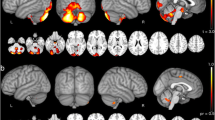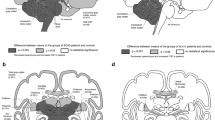Abstract
Background and objective
Neuropathological description of the brain in spinocerebellar ataxia type 1(SCA1) is limited to a few cases. Voxel-based morphometry (VBM) enables an unbiased in vivo whole-brain quantitative analysis of regional differences in gray matter (GM) and white matter (WM) volume. We assessed with VBM the structural damage in patients with genetically confirmed SCA1.
Method
Fifteen SCA1 patients and 15 age-matched healthy controls underwent MR examination with acquisition of high-resolution T1-weighted images. The results were correlated with the disease duration and severity of the clinical deficit assessed with the International Cerebellar Ataxia Rating Scale (ICARS) and Inherited Ataxia Clinical Rating Scale (IACRS).
Results
As compared to controls, patients with SCA1 showed a significant (p < 0.05 corrected for multiple comparison) symmetric loss of volume of the GM in the rostral cerebellar vermis and paramedian portions of the anterior cerebellar lobes. WM was decreased in the peridentate region and middle cerebellar peduncles but not in the pons. No GM or WM volume loss was found in the cerebral hemispheres. The cerebellar and brainstem GM and WM volume loss correlated with disease duration and the ICARS and IACRS scores.
Conclusions
VBM confirms that atrophy predominantly involves the brainstem and cerebellum in SCA1. The correlation with the clinical features indicates that VBM might be useful to monitor disease progression.
Similar content being viewed by others
References
Brenneis C, Boesch SM, Schocke M, Wenning GK, Poewe W (2003) Atrophy pattern in SCA2 determined by voxelbased morphometry. Neuroreport 14:1799–1802
Burk K, Abele M, Fetter M, Dichgans J, Skalej M, Laccone F, et al. (1996) Autosomal dominant cerebellar ataxia type I. Clinical features and MRI in families with SCA1, SCA2 and SCA3. Brain 119:1497–1505
Di Prospero NA, Fishbeck KH (2005) Therapeutics development for triple repeat expansion disease. Nat Rev Genet 6:756–765
Filla A, DeMichele G, Caruso G, Marconi R, Campanella G (1990) Genetic data and natural history of Friedreich’s disease: a study of 80 Italian patients. J Neurol 237:345–351
Gilman S, Sima AA, Junck L, Kluin KJ, Koeppe RA, Lohman ME, et al. (1996) Spinocerebellar ataxia type1 with multiple system degeneration and glial cytoplasmic inclusions. Ann Neurol 39:241–255
Good CD, Johnsrude IS, Ashburner J, Henson RN, Friston KJ, Frackowiak RS (2001) A voxel-based morphometric study of ageing in 465 normal adult human brains. NeuroImage 14:21–36
Good CD, Scahill RI, Fox NC, Ashburner J, Friston KJ, Chan D, et al. (2002) Automatic differentiation of anatomical patterns in the human brain: validation with studies in degenerative dementias. NeuroImage 17:29–46
Guerrini L, Lolli F, Ginestroni A, Belli G, Della Nave R, Tessa C et al. (2004) Brainstem neurodegeneration correlates with clinical dysfunction in SCA1 but not in SCA2. A volumetric, diffusion and quantitative proton spectroscopy MR study. Brain 127:1785–1795
Klockgether T, Skalej M, Wedekind D, Luft AR, Welte D, Schulz JB, et al. (1998) Autosomal dominant cerebellar ataxia type I. MRI-based volumetry of posterior fossa structures and basal ganglia in spinocerebellar ataxia types 1, 2 and 3. Brain 121:1678–1693
Klockgether T (2000) Handbook of Ataxia Disorders. New York, Marcel Dekker
Iwabuchi K, Tsuchiya K, Uchihara T, Yagishita S (1999) Autosomal dominant spinocerebellar degenerations. Clinical, pathological, and genetic correlations. Rev Neurol (Paris) 155:255–270
Lasek K, Lencer R, Gaser C, Hagenah J, Walter U, Wolters A, et al. (2006) Morphological basis for the spectrum of clinical deficits in spinocerebellar ataxia 17 (SCA17) Brain 129:2341–2352
Lukas C, Schols L, Bellenberg B, Rüb U, Przuntek H, Schmid G, et al. (2006) Dissociation of grey and white matter reduction in spinocerebellar ataxia type 3 and type 6: a voxel-based morphometry study. Neurosci Lett 408:230–235
Minnerop M, Specht K, Ruhlmann J, Schimke N, Abele M, Weyer A, et al. (2007) Voxel-based morphometry and voxel-based relaxometry in multiple system atrophy – A comparison between clinical subtypes and correlations with clinical parameters. Neuro-Image 15:1086–1095
Nagaoka U, Suzuki Y, Kawanami T, Kurita K, Shikama Y, Honda K, et al. (1999) Regional differences in genetic subgroup frequency in hereditary cerebellar ataxia, and a morphometric study of brain MR images in SCA1, MJD and SCA6. J Neurol Sci 164:187–194
Pareyson D, Gellera C, Castellotti B, Antonelli A, Riggio MC, Mazzucchelli F, et al. (1999) Clinical and molecular studies in 73 Italian families with autosomal dominant cerebellar ataxia type I: SCA 1 and SCA 2 are the most common genotypes. J Neurol 246:389–393
Savoiardo M, Strada L, Girotti F, Zimmerman RA, Grisoli M, Testa D, et al. (1990) Olivopontocerebellar atrophy: MR diagnosis and relationship to multi-system atrophy. Radiology 174:693–696
Schmahmann JD, Doyon J, McDonald D, Holmes C, Lavoie K, Hurwitz AS, et al. (1999) Three-dimensional MRI atlas of the human cerebellum in proportional stereotaxic space. Neuro- Image 10:233–260
Schols L, Amoiridis G, Buttner T, Przuntek H, Epplen JT, Riess O (1997) Autosomal dominant cerebellar ataxia: phenotypic differences in genetically defined subtypes? Ann Neurol 42:924–932
Specht K, Minnerop M, Abele M, Reul J, Wullner U, Klockgether T (2003) In vivo voxel-based morphometry in multiple system atrophy of the cerebellar type. Arch Neurol 60:1431–1435
Trouillas P, Takayanagi T, Hallett M, Currier RD, Subramony SH, Wessel K, et al. (1997) International Cooperative Ataxia Rating Scale for pharmacological assessment of the cerebellar syndrome. The Ataxia Neuropharmacology Committee of the World Federation of Neurology. J Neurol Sci 145:205–211
Author information
Authors and Affiliations
Corresponding author
Rights and permissions
About this article
Cite this article
Ginestroni, A., Della Nave, R., Tessa, C. et al. Brain structural damage in spinocerebellar ataxia type 1. J Neurol 255, 1153–1158 (2008). https://doi.org/10.1007/s00415-008-0860-4
Received:
Revised:
Accepted:
Published:
Issue Date:
DOI: https://doi.org/10.1007/s00415-008-0860-4




